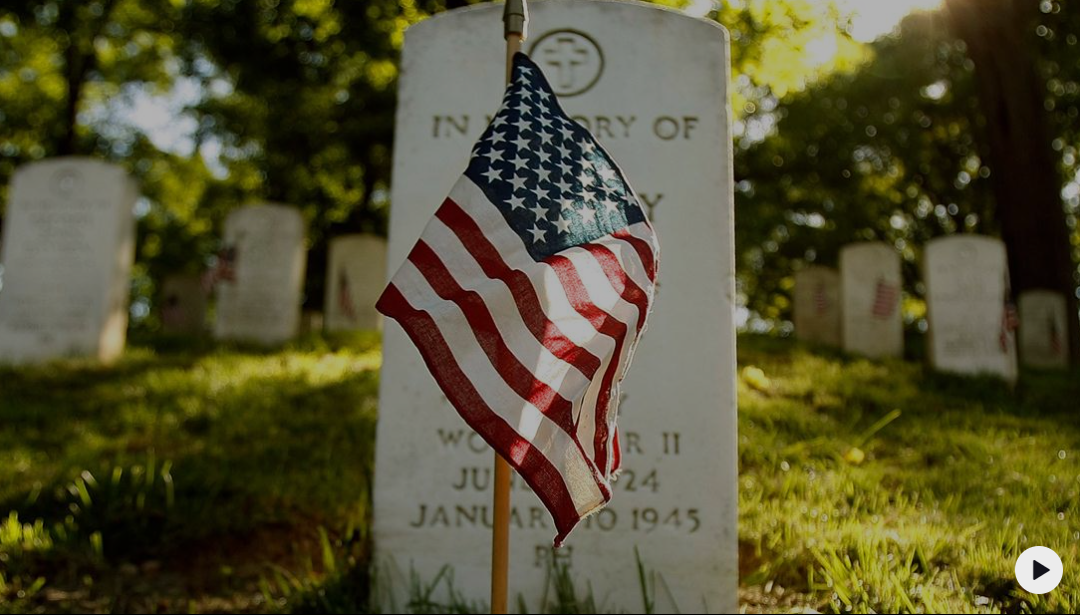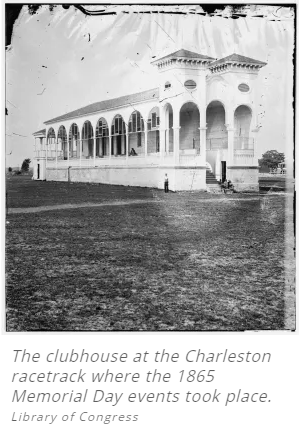Dozens of U.S. cities claim to be the “first” to commemorate the lives lost during the Civil War.
Waterloo, New York; Columbus, Georgia; and Carbondale, Illinois are just a few. But one city often left out of the conversations is Charleston, South Carolina — even though its commemoration happened an entire year before every other city’s.
In May of 1865, thousands of newly freed Black Charlestonians exhumed a mass grave of dead Union soldiers, reburied their bodies and commemorated their lives with a parade.
The holiday we know as Memorial Day was first called Decoration Day. Over the years, that name changed to Dedication Day.
It wasn’t until the 1960s when Memorial Day became the official name. Regardless of what you call it, the first observance of Memorial Day can be traced back to an old Charleston race course.
And we know about this important history because of David Blight, an African American studies professor at Yale University and author of “Race and Reunion.”
LX News storyteller Jalyn Henderson caught up with Blight to learn more about this historic event.
Jalyn: This ceremony happened hundreds of years ago. There are very few photos or even documentation of it happening. How and when did you learn about it?
David: “In the 1990’s, I was at Harvard University on a fellowship. I was in the library, and I was working in a collection of Union veterans’ papers that were not very organized. [The library] turned these boxes over to me and in one of the boxes in a file labeled ‘The First Decoration Day,’ I found this story. It was written on a large piece of cardboard, probably by an old veteran. And it was recording the story, or part of it, from a newspaper article that had appeared in the New York Tribune in May of 1865. He wrote this extraordinary tale about this parade that occurred on a horse track, a race course in Charleston, South Carolina, led by African American former slaves in early May 1865. And when I first read it, I really could hardly believe it. I thought, ‘This is some old veteran making up something.'”
Jalyn: What exactly happened on that day?
David: “According to the press, about 10,000 people were on this old race course, led by Black children and by women and men. They were followed by Union soldiers singing hymns, singing ‘John Brown’s Body’ as they marched, commemorating the nearly 260 Union dead soldiers who had been buried in that gravesite without names. There were other eyewitnesses. Preachers preached. Then they all broke up and went back into the infield of the race track and did what most of us do today. They held picnics, they had speeches, children ran races and so on and so forth. So it was their way of dedicating not only the graves of the dead, but it was also their way of declaring the meaning of the Civil War and declaring a federal Union victory.”
Jalyn: This sounds like a big event that had a lot of community involvement. Why haven’t we heard about it before?
David: “I think it’s a classic case of how public collective memory works. This was not a story white Charlestonians wanted to remember. And as we now know, it never died in the kind of community, public memory of Black Charlestonians, but the ‘Lost Cause’ story took over Southern memory by the end of Reconstruction and through the latter part of the 19th century. The ‘Lost Cause’ story became so prevalent that this story had no chance of being remembered publicly. It just didn’t belong in the same story as all this honoring of the Confederate dead and the honoring of Southern soldiers and the honoring of soldierly value as they conceived it. It’s extraordinary, though, to think of how many people actually witnessed it.”
Jalyn: Why is it important that we preserve this history?
David: “As a historian, you probably can expect my answer. Everything’s worth recording and preserving and keeping because we don’t know what it’s going to mean 100 years later. We don’t know what it’s going to mean to subsequent generations. We don’t know how the story’s going to be shaped and reshaped by new evidence. This first Memorial Day is just a microcosm. You know, it’s a classic small example of a sort of remarkable event — let’s face it, that just got almost completely lost.”
THE STORY
Memorial Day was born out of necessity. After the American Civil War, a battered United States was faced with the task of burying and honoring the 600,000 to 800,000 Union and Confederate soldiers who had died in the single bloodiest military conflict in American history. The first national commemoration of Memorial Day was held in Arlington National Cemetery on May 30, 1868, where both Union and Confederate soldiers are buried.
Several towns and cities across America claim to have observed their own earlier versions of Memorial Day or “Decoration Day” as early as 1866. (The earlier name is derived from the fact that decorating graves was and remains a central activity of Memorial Day.) But it wasn’t until a remarkable discovery in a dusty Harvard University archive the late 1990s that historians learned about a Memorial Day commemoration organized by a group of Black people freed from enslavement less than a month after the Confederacy surrendered in 1865.
Back in 1996, David Blight, a professor of American History at Yale University, was researching a book on the Civil War when he had one of those once-in-a-career eureka moments. A curator at Harvard’s Houghton Library asked if he wanted to look through two boxes of unsorted material from Union veterans.
“There was a file labeled ‘First Decoration Day,’” remembers Blight, still amazed at his good fortune. “And inside on a piece of cardboard was a narrative handwritten by an old veteran, plus a date referencing an article in The New York Tribune. That narrative told the essence of the story that I ended up telling in my book, of this march on the race track in 1865.”
The race track in question was the Washington Race Course and Jockey Club in Charleston, South Carolina. In the late stages of the Civil War, the Confederate army transformed the formerly posh country club into a makeshift prison for Union captives. More than 260 Union soldiers died from disease and exposure while being held in the race track’s open-air infield. Their bodies were hastily buried in a mass grave behind the grandstands.
READ MORE: 8 Things You May Not Know About Memorial Day
When Charleston fell and Confederate troops evacuated the badly damaged city, those freed from enslavement remained. One of the first things those emancipated men and women did was to give the fallen Union prisoners a proper burial. They exhumed the mass grave and reinterred the bodies in a new cemetery with a tall whitewashed fence inscribed with the words: “Martyrs of the Race Course.”

The Battle of Fort Wagner on Morris Island was the Union attack on July 18, 1863, led by the 54th Massachusetts Volunteer Infantry. The infantry was one of the first major American military units made up of Black soldiers. Buyenlarge/Getty Images
If the news reports are accurate, the 1865 gathering at the Charleston race track would be the earliest Memorial Day commemoration on record. Blight excitedly called the Avery Institute of Afro-American History and Culture at the College of Charleston, looking for more information on the historic event.
“‘I’ve never heard of it,’ they told me,” says Blight. “‘This never happened.’”
But it was clear from the newspaper reports that a Memorial Day observance was organized by freed slaves in Charleston at least a year before other U.S. cities and three years before the first national observance. How had been lost to history for over a century?
“This was a story that had really been suppressed both in the local memory and certainly the national memory,” says Blight. “But nobody who had witnessed it could ever have forgotten it.”
Blight kept digging for more information, but the only other mention he found of the race track event was in a 1916 correspondence sent from a women’s Civil War historical society in New Orleans to its sister chapter in Charleston, asking about a big parade of freed slaves on a horse track at the end of the war.
“I regret that I was unable to gather any official information in answer to this,” wrote the Charleston society’s president.
“That’s such a telling statement,” says Blight. “The woman who wrote that letter may not have known about it, but the fact that she didn’t tells the story.”

A sketch of the Union Soldiers cemetery, reading the “Martyrs of the Race course,” in Charleston, South Carolina.Library of Congress
Once the war was over and Charleston was rebuilt in the 1880s, the city’s white residents likely had little interest in remembering an event held by former enslaved people to celebrate the Union dead. “That didn’t fit their version of what the war was all about,” says Blight.
In time, the old horse track and country club were torn down, and thanks to a gift from a wealthy Northern patron, the Union soldiers’ graves were moved from the humble white-fenced graveyard in Charleston to the Beaufort National Cemetery. By the time Blight was rummaging through the Harvard archives in 1996, the story of the first Memorial Day had been entirely forgotten.
Or perhaps not entirely.
After his book Race and Reunion was published in 2001, Blight gave a talk about Memorial Day at the Smithsonian National Museum of American History, and after it was finished, an older Black woman approached him.
“You mean that story is true?” the woman asked Blight. “I grew up in Charleston, and my granddaddy used to tell us this story of a parade at the old race track, and we never knew whether to believe him or not. You mean that’s true?”
For Blight, it’s less important whether the 1865 commemoration of the “Martyrs of the Race Course” is officially recognized as the first Memorial Day.
“It’s the fact that this occurred in Charleston at a cemetery site for the Union dead in a city where the Civil war had begun,” says Blight, “and that it was organized and done by African American former slaves is what gives it such poignancy.”
And then on May 1, 1865, something even more extraordinary happened. According to two reports that Blight found in The New York Tribune and The Charleston Courier, a crowd of 10,000 people, mostly freed slaves with some white missionaries, staged a parade around the race track. Three thousand Black schoolchildren carried bouquets of flowers and sang “John Brown’s Body.” Members of the famed 54th Massachusetts and other Black Union regiments were in attendance and performed double-time marches. Black ministers recited verses from the Bible.
–lx.com / history.com




